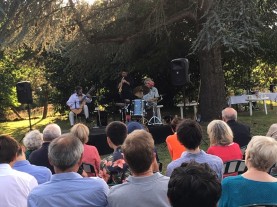
Introduction
Le mariage est une célébration riche en traditions, et parmi celles-ci, le vin d'honneur occupe une place particulière. Moment convivial et festif, le vin d'honneur permet de partager un moment de joie avec un plus grand nombre de personnes, souvent en dehors du cercle restreint des invités du repas de mariage. Cet article explore les origines, les pratiques actuelles et les éléments clés pour organiser un vin d'honneur réussi.
Origines et Évolution du Vin d'Honneur
Origines Historiques
Le vin d'honneur trouve ses racines dans les traditions françaises du XIXe siècle. À l'origine, il s'agissait d'un simple verre de vin offert aux invités après la cérémonie religieuse pour les remercier de leur présence. Ce moment permettait également aux mariés de recevoir les félicitations des convives.
Évolution
Au fil du temps, le vin d'honneur a évolué pour devenir un véritable apéritif prolongé, souvent agrémenté de diverses boissons et de nombreux amuse-bouches. Aujourd'hui, il est généralement offert après la cérémonie civile ou religieuse et avant le dîner de réception. C'est une occasion pour les mariés de saluer tous leurs invités, y compris ceux qui ne sont pas conviés au repas de mariage.
Organisation du Vin d'Honneur
Choix du Lieu
Le lieu du vin d'honneur est crucial pour la réussite de cet événement. Il peut se tenir dans un jardin, une salle de réception ou même dans l'enceinte du lieu de la cérémonie. L'essentiel est de choisir un endroit accessible, agréable et suffisamment spacieux pour accueillir tous les invités.
Boissons et Amuse-bouches
Traditionnellement, le vin d'honneur met en avant une variété de vins, dont le fameux champagne, emblème de la célébration en France. Cependant, il est courant d'y trouver également des cocktails, des jus de fruits et des boissons sans alcool pour satisfaire tous les goûts.
Les amuse-bouches doivent être variés et raffinés. Canapés, petits fours, verrines et autres délicatesses sont disposés sur des buffets pour offrir une expérience culinaire agréable et conviviale. La qualité et la présentation des mets sont essentielles pour laisser une impression positive.
Durée et Timing
Le vin d'honneur dure généralement entre une et deux heures. Il doit être suffisamment long pour permettre aux mariés de saluer tous leurs invités sans pour autant trop s'éterniser, afin de respecter le timing de la journée et de laisser place au dîner de réception.
Animation et Ambiance
Pour créer une ambiance festive, il est possible d'agrémenter le vin d'honneur avec des animations musicales, des artistes de rue, ou même des jeux pour divertir les invités. Un fond musical discret, souvent assuré par un groupe latino, jazz ou un DJ, permet de maintenir une atmosphère chaleureuse et agréable.
Tendences Actuelles
Thématiques et Personnalisation
De plus en plus de couples choisissent de personnaliser leur vin d'honneur en lui donnant un thème spécifique. Que ce soit un thème champêtre, vintage, bohème ou encore exotique, la décoration et les choix culinaires sont souvent alignés sur ce thème pour offrir une expérience unique et mémorable.
Écologie et Durabilité
Avec une conscience écologique croissante, de nombreux mariés optent pour un vin d'honneur plus durable. Cela inclut l'utilisation de produits locaux et bio, la réduction des déchets avec des solutions zéro déchet et la préférence pour des décorations réutilisables ou recyclables.
Innovations Gastronomiques
Les tendances culinaires influencent également le vin d'honneur. Les food trucks, les bars à thème (à huîtres, à fromages, à tapas) et les dégustations interactives sont de plus en plus populaires. Ces options offrent une dimension ludique et gourmande à l'événement.
Conclusion
Le vin d'honneur est une tradition vivante et en constante évolution, qui s'adapte aux goûts et aux aspirations des mariés contemporains. Qu'il soit classique ou innovant, cet événement reste un moment clé du mariage, permettant de partager la joie de ce jour unique avec un grand nombre de personnes. Pour réussir un vin d'honneur, il est essentiel de bien choisir le lieu, les boissons et les amuse-bouches, tout en créant une ambiance conviviale et festive.

 Posted by
Posted by



